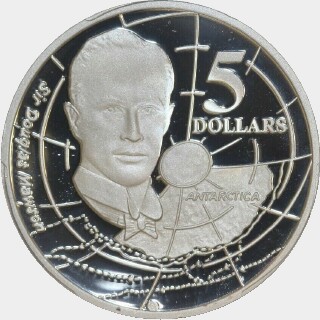



?
The Australian Explorers series was produced as part of the 1993 and 1994 Masterpieces in Silver sets each featuring five 5 dollar coins with the 1993 set bearing portrait(s) of Australian explorers against a map of Australia and the 1994 set bearing the portrait of Australian explorers against the regions they navigated.
Sir Douglas Mawson (1882-1958) was an Australian geologist and explorer famous for his leading role in the Australasian Antarctic Expedition. He was also a recognised professor in geology and mineralogy at the University of Adelaide, and his research contributed greatly to Australian geology. Mawson was born on 5 May 1882 in Shipley, Yorkshire, England. When he was two years old, his family moved to Rooty Hill, a suburb of Sydney, Australia, where he studied mining engineering at the University of Sydney and completed his bachelor's degree in 1902. A year later he was first exposed to scientific exploration by joining an expedition to the New Hebrides (presently Vanuatu). His noted, early writings include 'The Geology of the New Hebrides' and his paper on Mittagong, New South Wales.
In 1905 he became a lecturer at the University of Adelaide, teaching mineralogy and petrology. Mawson was involved in two major expeditions during the Heroic Age of Antarctic Exploration: the British Antarctic Expedition (1907-1909), also known as the Nimrod Expedition, and the Australasian Antarctic Expedition (1911-1914) (Jacka, F, J, 1986) . The former was led by Ernest Shackleton, primarily aimed at reaching the South Pole, whereas the latter was undertaken under Mawson's leadership with scientific objectives. Though the A.A.E. produced much knowledge in various fields, the journey was tragic as Mawson lost his two companions, Belgrave Ninnis, who fell into a crevasse, and Xavier Mertz, who suffered from vitamin A toxicity (Hypervitaminosis A) after eating Husky's livers. Mowson himself barely survived: he fell through another crevasse but was saved by his sledge jammed in the snow. His expedition experiences were described in his book, 'The Home of the Blizzard'.
In 1914 Mawson was knighted for his scientific contribution, and during World War I, he served in the British Ministry of Munitions, holding the rank of major. He was back to his academic studies at the University of Adelaide and became a professor in 1921. Apart from teaching and research in the university, he involved his students in geological field-work and enjoyed outdoor activities. He was also a leader of the British, Australian and New Zealand Antarctic Research Expedition (1929-1931), another important research expedition in Australian history. Mawson married Francisca Adriana (Paquita) Delprat in 1914 and had two daughters, Patricia and Jessica. He died at the age of 76 in Brighton from a cerebral haemorrhage. His image is featured on the Australian paper one hundred dollar note and on the one dollar coin released as part of the Inspirational Australians series. His remarkable achievements on his expedition are portrayed in 'Alone on the Ice: The Greatest Survival Story in the History of Exploration' (2013) by an American author David Roberts.
Find out what dealers are paying with a subscription.
Subscribe now!Find out what coins have actually sold for and where with a Standard/Professional subscription.
Subscribe now!